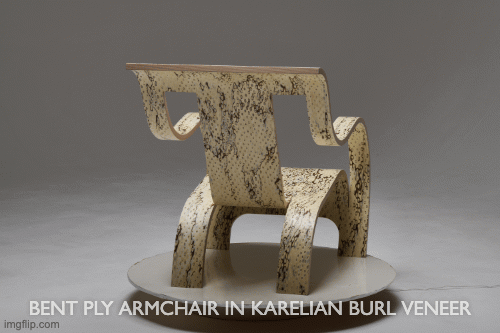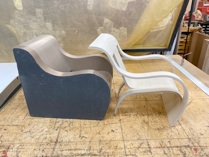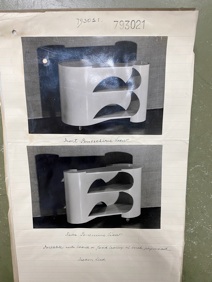<h1>news</h1>


Gerald SUmmers’ - Makers of simple Furniture
Bent ply Armchair
One of my most exciting projects for 2022 is that of reproducing of two of Gerald Summers’ classic designs from the 1930’s, further details of which can also be found on my dkuk.uk website.
The first, his iconic Bent Ply Armchair, is considered by many to be one of the most important pieces of 20th century design, and not only in the field of furniture making.
This chair was originally formed from six or seven identically cut layers of 3mm birch plywood pressed between the two halves of a large, and very heavy, solid wood mould.
The construction that I have used differs from that of Summers insomuch that I have laminated eleven layers of 1.5mm birch ply together over a single piece mould in a vacuum bag, a process that gives me considerably more options with regard to the thickness of the lamination and surface finish.
I made several prototypes at 25% and 50% scale before finally making the full size mould and pressing what may well be the first Bent Ply Armchair manufactured in England since the late 1930s. As well as the lacquered birch ply chair I have also made several versions with veneered faces, this representing a significant diversion from purely manufacturing faithful copies of the original chair. I intend to produce these in a wide range of natural and man-made veneers allowing them to fit in with any domestic or commercial interior.

This chair displays a degree of design flair and innovation in material usage that at least sets Summers on at least a par with his more widely acknowledged contemporaries such as Alvar Aalto and Marcel Breuer. To my mind, the simplicity and economy of material usage evident in the Bent Plywood Armchair set this design apart from all other plywood furniture of the era many of which were made up of many individual pieces or relied on additional strengthening or metal brackets to allow them to be suitable for daily use.
Summers’ inspiration has often been linked to his seeing Aalto’s plywood designs at an exhibition at Fortnum and Mason in later 1933 but, in actual fact, Summers submitted his design registration application for his chair at almost exactly the same period that the exhibition was taking place and so his design and development work must have predated this encounter by quite some time.
Even with the aid of CAD and CNC machining this is not an easy piece of furniture to manufacture and I find it difficult to imagine the amount of work that went into the initial design and prototyping phases with the technology available in the 1930’s.
Given the value of original bent ply armchairs, of which it is commonly estimated only 120 were made (although some experts believe the figure to be significantly lower), it seems doubtful that many of the surviving examples are actually being sat on regularly. This is just a crying shame for a piece of furniture which is not only beautiful to look at but which is also supremely comfortable, even without a cushion or upholstery. As a point of interest, an upholstery option was offered by the Makers of Simple Furniture but I have yet to see a single image of an armchair other than in clear lacquered birch ply or black/white paint.
Lacquered birch ply reproductions are priced at £2450 including VAT (£2040 ex VAT)
Veneered reproductions are priced at £2950 including VAT (£2460 ex VAT)

The machined layers of ply demonstrate just how economical the material usage is in the manufacture of the Bent Ply Armchair


The initial moulds for the two scaled prototype chairs were CNC cut from polystyrene foam.

The full size production mould is made of layers of MDF and, even with several thousand weight saving holes being drilled, it still probably tips the scales at well over 150kg. It is shown here with an unglued layup in place to test the geometry of the mould and machining of the plywood layers. Because of the various stages of prototyping that had been undergone there was very little to tweak by the time we got to going to 100%.


Gerald Summers ‘isokon’ tea trolley
The second Gerald Summers piece that I am remaking is his Tea Trolley. Summers’ connection with Jack Pritchard’s Isokon company was through Pritchard’s involvement with Venesta, the manufacturer of the birch plywood used by Summers in his furniture making. Summers designed the tea trolley for the Isokon building in North West London and it is believed that fewer than twenty originals were made, with a much smaller number surviving until the present day. The onset of WWII led to plywood being almost impossible to source and in May 1939, after having been registered in 1934, Jack Pritchard instructed his patent lawyers, Rowe and Maw, to pass up the option of extending the design protection on the Tea Trolley for a further five years.
Isokon Plus made three lacquered birch ply reproductions of the Tea Trolley in the early 2000s before ceasing production due to technical problems, the nature of which are unclear.
One possible issue may have been that the 3mm birch ply commonly available in the UK is neither made in the appropriate sheet size nor manufactured with equal thicknesses of constructional veneer, the centre layer being considerably thicker that 1mm. This means that standard 3mm birch ply is actually too stiff to comfortably bend around the tighter end of the tea trolley. I have commissioned a batch of 3mm ply from a manufacturer in Finland which is designed specifically with the tea trolley in mind and this should be delivered early in 2022.
In the meantime I have made two examples of the tea trolley from sheets of cherry and walnut plywood pressed in my workshop. These were constructed with a central layer of 0.6mm veneer and two outer layers of 1.5mm constructional veneer, which, after calibration sanding finished at almost exactly 3mm thick. These custom ply sheets are very much more flexible than normal birch ply and were easy to form around the shape of the three shelves but are fairly labour intensive to produce.
The outer skin is nailed to the shelves using 1.6mm diameter dome headed solid brass nails in keeping with the fixing which can be seen on the original registration document.

This is the original design registration document for the Tea Trolley, held at the National Archive in Kew, London. Filed in 1934 it is registered to Jack Pritchard’s Isokon company.